As I am primarily a Hawthorne/ 19th century New England Lit. scholar, Salem and Concord Massachusetts are among my most frequent and revered Meccas. I was down in Concord last week, visited some familiar sites, and I took some pictures.
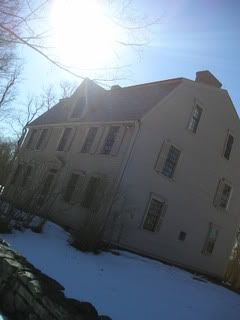
Hawthorne's famous "Old Manse," where the "Mosses" were from.
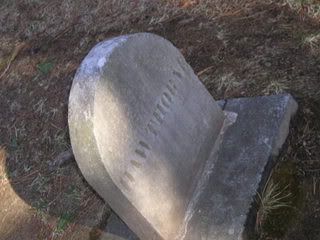
Nathaniel's grave on "Author's Ridge."
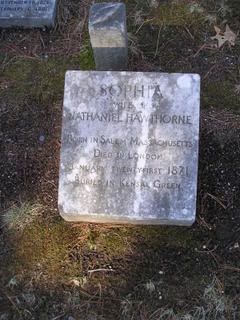
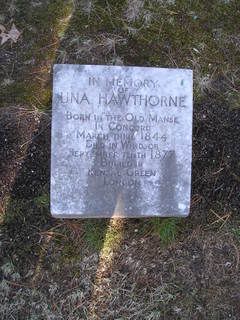
The commemorative stones for Nathaniel's wife Sophia and daughter Una, placed on this spot in a ceremony that took place since my last visit to Concord, next to the author's own stone within the Hawthorne family plot. These were actually among the things that I was most interested in seeing on this particular trip.
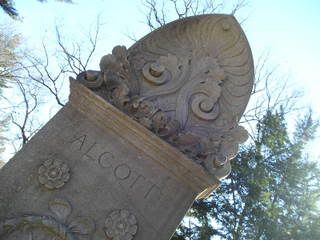
The stone at the center of the Alcott family plot at "Author's Ridge." I love the stonework on this one.
I'm considering buying a video-camera, filming these nerdy excursions, and becoming the next Fritz Wethersbee. Think I can pull it off? (For those outside New England unfamiliar with Fritz, check this out.)
A large part of these trips usually entails searching for long out-of-print books that I need to find for research purposes. On this particular trip, I once again didn't find the one that I was most specifically looking for. If anyone happens to know where I might be able to find a copy of Julian Hawthorne's biography of his father in two volumes, "Nathaniel Hawthorne and His Wife," please let me know. Yes, I'm well aware that there's a copy at the Fletcher Library at ASU West. And yes, it does even happen to have a book-plate inside the cover from a New Hampshire parochial school that later became the high-school that I graduated from. Unfortunately, that's not terribly helpful to me right now, which is a bit of a sore subject.
I DID find something else interesting while searching this time around, though... I stumbled on an early Italian copy of Hawthorne's "Transformations," which was later released in America, in a "slightly" different form as "The Marble Faun." What I wasn't aware of, however, as I had never actually seen a copy of the earlier European form of the work, was that he "slight" differences between "Transformations" and "The Marble Faun" somehow made the earlier version of the work about a quarter of the length of the final American version. I can't wait to dig into the older work in more detail and figure out where the differences lie. Differences in the prefaces of the two works in particular could potentially add pertinent depth to some of my present research, and thus I consider the dusty old book a rather essential and exciting find.
When I started flipping through the book, I found some other suprises that made me smile.

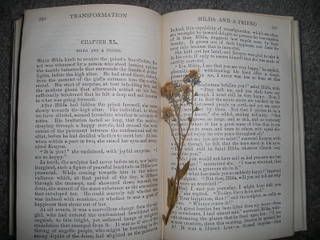
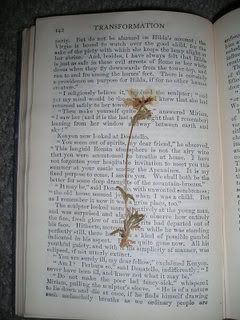
There is a pencilled inscription in the front cover of the book, with a girl's name, a rather antique date, and a town in Italy. My mind naturally imediately began running with stories of the situations that led to these flowers becoming pressed within the pages of this book, and the symbolic and poetic significance of the words that surround the dried Italian flowers and thoughts of the girl who had placed them there, with presumably little thought of how alligned she was with which characters of the tale that she happened to be reading.
Even if it's not completely true, even if the flowers were placed in the book a mere year ago by an elderly American woman before her collection was sold with her estate to the book-seller, I don't want to know. These thoughts of the little Italian girl drying flowers a hundred-something years ago in her early-pressing of my favorite book definitely made my day.
In other news of the blurring of the lines between "fiction" and "non-," I stumbled on an intriguing set of quotes in the "Author's Preface" to Henry James' "The Turn of the Screw."
"I wondered, I confess, why so fine a germ, gleaming there in the wayside dust of life, had never been deftly picked up. The thing had for me the immense merit of allowing the imagination absolute freedom of hand, of inviting it to act on a perfectly clear field, with no 'outside' control involved, no pattern of the usual or the true or the terrible 'pleasant' (save always, of course, the high pleasentry of one's very form) to consort with."
"The charm of all these things for the distracted modern mind is in the clear field of experience, as I call it, over which we are thus led to roam; an annexed but independent world in which nothing is right save as we rightly imagine it."


No comments:
Post a Comment